Business and the Business Environment: Asda Analysis Report
VerifiedAdded on 2023/01/12
|17
|5384
|89
Report
AI Summary
This report provides a comprehensive analysis of the business environment of Asda, a major British supermarket chain. It begins by differentiating between profit, non-profit, and non-government organizations and then explores the legal structures of businesses, including sole traders, partnerships, and private limited companies, providing examples for each. The report then delves into the interrelationship of various organizational functions, such as marketing, sales, HR, and organizational structure, and how they contribute to achieving organizational objectives. A PESTEL analysis is conducted to examine the macro-environmental factors impacting Asda, followed by a micro-environmental analysis. Finally, a TOWS matrix is utilized to interrelate the micro and macro environmental factors, synthesizing the analysis to understand Asda's strategic position within the market. The report draws on various sources and provides a detailed overview of Asda's operations and its competitive landscape.

BUSINESS AND THE
BUSINESS ENVIRONMENT
(UNIT 1
BUSINESS ENVIRONMENT
(UNIT 1
Paraphrase This Document
Need a fresh take? Get an instant paraphrase of this document with our AI Paraphraser
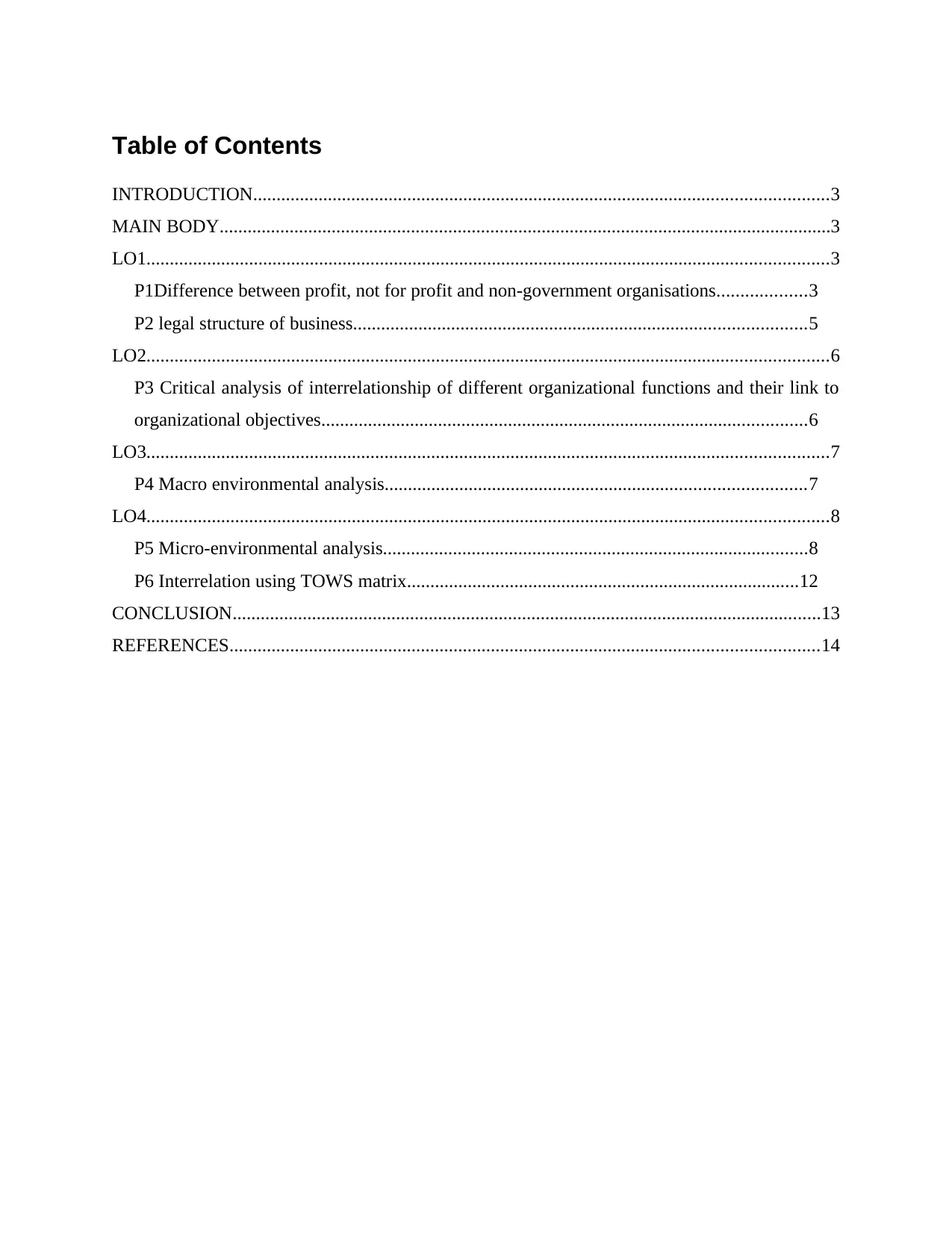
Table of Contents
INTRODUCTION...........................................................................................................................3
MAIN BODY...................................................................................................................................3
LO1..................................................................................................................................................3
P1Difference between profit, not for profit and non-government organisations...................3
P2 legal structure of business.................................................................................................5
LO2..................................................................................................................................................6
P3 Critical analysis of interrelationship of different organizational functions and their link to
organizational objectives........................................................................................................6
LO3..................................................................................................................................................7
P4 Macro environmental analysis..........................................................................................7
LO4..................................................................................................................................................8
P5 Micro-environmental analysis...........................................................................................8
P6 Interrelation using TOWS matrix....................................................................................12
CONCLUSION..............................................................................................................................13
REFERENCES..............................................................................................................................14
INTRODUCTION...........................................................................................................................3
MAIN BODY...................................................................................................................................3
LO1..................................................................................................................................................3
P1Difference between profit, not for profit and non-government organisations...................3
P2 legal structure of business.................................................................................................5
LO2..................................................................................................................................................6
P3 Critical analysis of interrelationship of different organizational functions and their link to
organizational objectives........................................................................................................6
LO3..................................................................................................................................................7
P4 Macro environmental analysis..........................................................................................7
LO4..................................................................................................................................................8
P5 Micro-environmental analysis...........................................................................................8
P6 Interrelation using TOWS matrix....................................................................................12
CONCLUSION..............................................................................................................................13
REFERENCES..............................................................................................................................14
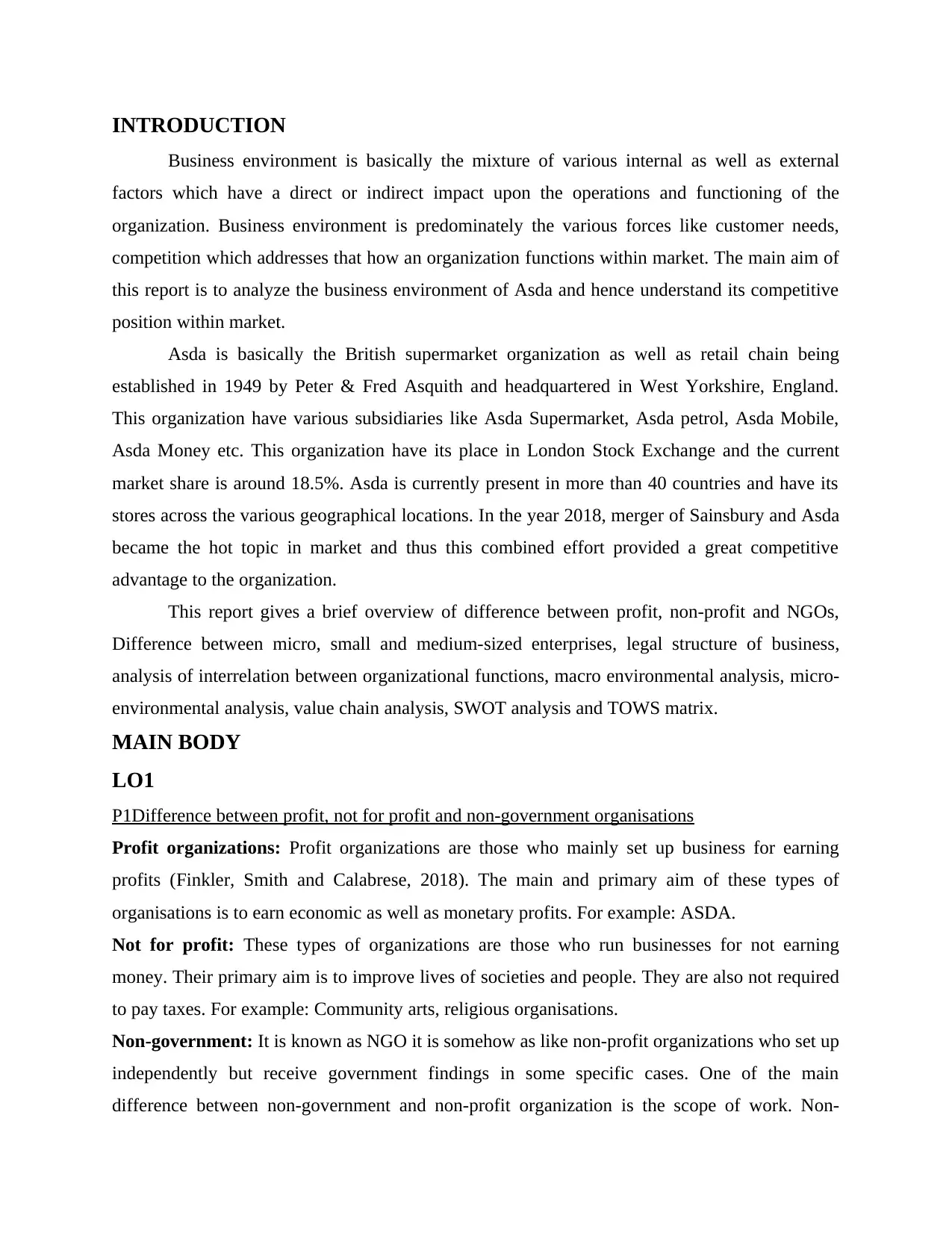
INTRODUCTION
Business environment is basically the mixture of various internal as well as external
factors which have a direct or indirect impact upon the operations and functioning of the
organization. Business environment is predominately the various forces like customer needs,
competition which addresses that how an organization functions within market. The main aim of
this report is to analyze the business environment of Asda and hence understand its competitive
position within market.
Asda is basically the British supermarket organization as well as retail chain being
established in 1949 by Peter & Fred Asquith and headquartered in West Yorkshire, England.
This organization have various subsidiaries like Asda Supermarket, Asda petrol, Asda Mobile,
Asda Money etc. This organization have its place in London Stock Exchange and the current
market share is around 18.5%. Asda is currently present in more than 40 countries and have its
stores across the various geographical locations. In the year 2018, merger of Sainsbury and Asda
became the hot topic in market and thus this combined effort provided a great competitive
advantage to the organization.
This report gives a brief overview of difference between profit, non-profit and NGOs,
Difference between micro, small and medium-sized enterprises, legal structure of business,
analysis of interrelation between organizational functions, macro environmental analysis, micro-
environmental analysis, value chain analysis, SWOT analysis and TOWS matrix.
MAIN BODY
LO1
P1Difference between profit, not for profit and non-government organisations
Profit organizations: Profit organizations are those who mainly set up business for earning
profits (Finkler, Smith and Calabrese, 2018). The main and primary aim of these types of
organisations is to earn economic as well as monetary profits. For example: ASDA.
Not for profit: These types of organizations are those who run businesses for not earning
money. Their primary aim is to improve lives of societies and people. They are also not required
to pay taxes. For example: Community arts, religious organisations.
Non-government: It is known as NGO it is somehow as like non-profit organizations who set up
independently but receive government findings in some specific cases. One of the main
difference between non-government and non-profit organization is the scope of work. Non-
Business environment is basically the mixture of various internal as well as external
factors which have a direct or indirect impact upon the operations and functioning of the
organization. Business environment is predominately the various forces like customer needs,
competition which addresses that how an organization functions within market. The main aim of
this report is to analyze the business environment of Asda and hence understand its competitive
position within market.
Asda is basically the British supermarket organization as well as retail chain being
established in 1949 by Peter & Fred Asquith and headquartered in West Yorkshire, England.
This organization have various subsidiaries like Asda Supermarket, Asda petrol, Asda Mobile,
Asda Money etc. This organization have its place in London Stock Exchange and the current
market share is around 18.5%. Asda is currently present in more than 40 countries and have its
stores across the various geographical locations. In the year 2018, merger of Sainsbury and Asda
became the hot topic in market and thus this combined effort provided a great competitive
advantage to the organization.
This report gives a brief overview of difference between profit, non-profit and NGOs,
Difference between micro, small and medium-sized enterprises, legal structure of business,
analysis of interrelation between organizational functions, macro environmental analysis, micro-
environmental analysis, value chain analysis, SWOT analysis and TOWS matrix.
MAIN BODY
LO1
P1Difference between profit, not for profit and non-government organisations
Profit organizations: Profit organizations are those who mainly set up business for earning
profits (Finkler, Smith and Calabrese, 2018). The main and primary aim of these types of
organisations is to earn economic as well as monetary profits. For example: ASDA.
Not for profit: These types of organizations are those who run businesses for not earning
money. Their primary aim is to improve lives of societies and people. They are also not required
to pay taxes. For example: Community arts, religious organisations.
Non-government: It is known as NGO it is somehow as like non-profit organizations who set up
independently but receive government findings in some specific cases. One of the main
difference between non-government and non-profit organization is the scope of work. Non-
⊘ This is a preview!⊘
Do you want full access?
Subscribe today to unlock all pages.

Trusted by 1+ million students worldwide
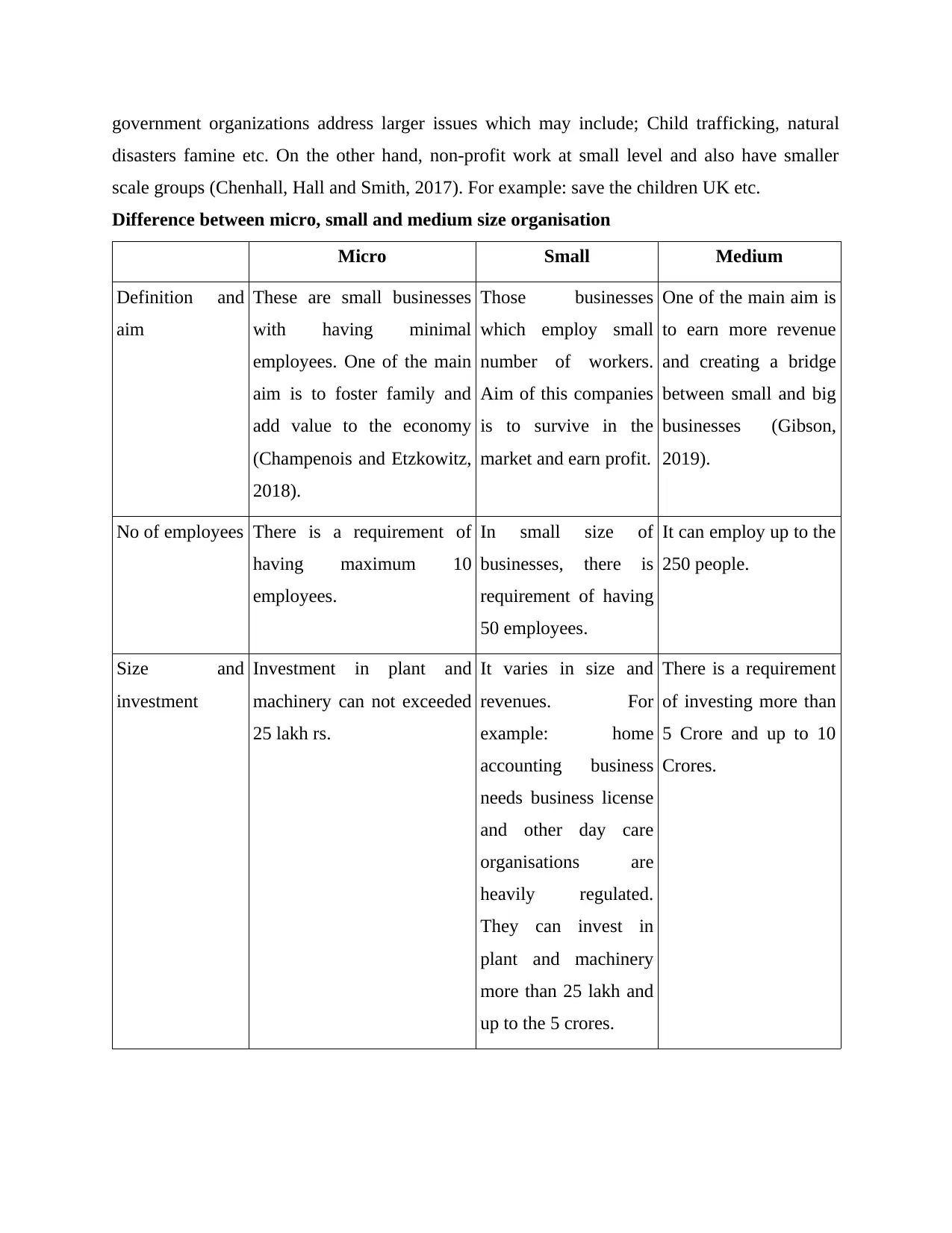
government organizations address larger issues which may include; Child trafficking, natural
disasters famine etc. On the other hand, non-profit work at small level and also have smaller
scale groups (Chenhall, Hall and Smith, 2017). For example: save the children UK etc.
Difference between micro, small and medium size organisation
Micro Small Medium
Definition and
aim
These are small businesses
with having minimal
employees. One of the main
aim is to foster family and
add value to the economy
(Champenois and Etzkowitz,
2018).
Those businesses
which employ small
number of workers.
Aim of this companies
is to survive in the
market and earn profit.
One of the main aim is
to earn more revenue
and creating a bridge
between small and big
businesses (Gibson,
2019).
No of employees There is a requirement of
having maximum 10
employees.
In small size of
businesses, there is
requirement of having
50 employees.
It can employ up to the
250 people.
Size and
investment
Investment in plant and
machinery can not exceeded
25 lakh rs.
It varies in size and
revenues. For
example: home
accounting business
needs business license
and other day care
organisations are
heavily regulated.
They can invest in
plant and machinery
more than 25 lakh and
up to the 5 crores.
There is a requirement
of investing more than
5 Crore and up to 10
Crores.
disasters famine etc. On the other hand, non-profit work at small level and also have smaller
scale groups (Chenhall, Hall and Smith, 2017). For example: save the children UK etc.
Difference between micro, small and medium size organisation
Micro Small Medium
Definition and
aim
These are small businesses
with having minimal
employees. One of the main
aim is to foster family and
add value to the economy
(Champenois and Etzkowitz,
2018).
Those businesses
which employ small
number of workers.
Aim of this companies
is to survive in the
market and earn profit.
One of the main aim is
to earn more revenue
and creating a bridge
between small and big
businesses (Gibson,
2019).
No of employees There is a requirement of
having maximum 10
employees.
In small size of
businesses, there is
requirement of having
50 employees.
It can employ up to the
250 people.
Size and
investment
Investment in plant and
machinery can not exceeded
25 lakh rs.
It varies in size and
revenues. For
example: home
accounting business
needs business license
and other day care
organisations are
heavily regulated.
They can invest in
plant and machinery
more than 25 lakh and
up to the 5 crores.
There is a requirement
of investing more than
5 Crore and up to 10
Crores.
Paraphrase This Document
Need a fresh take? Get an instant paraphrase of this document with our AI Paraphraser
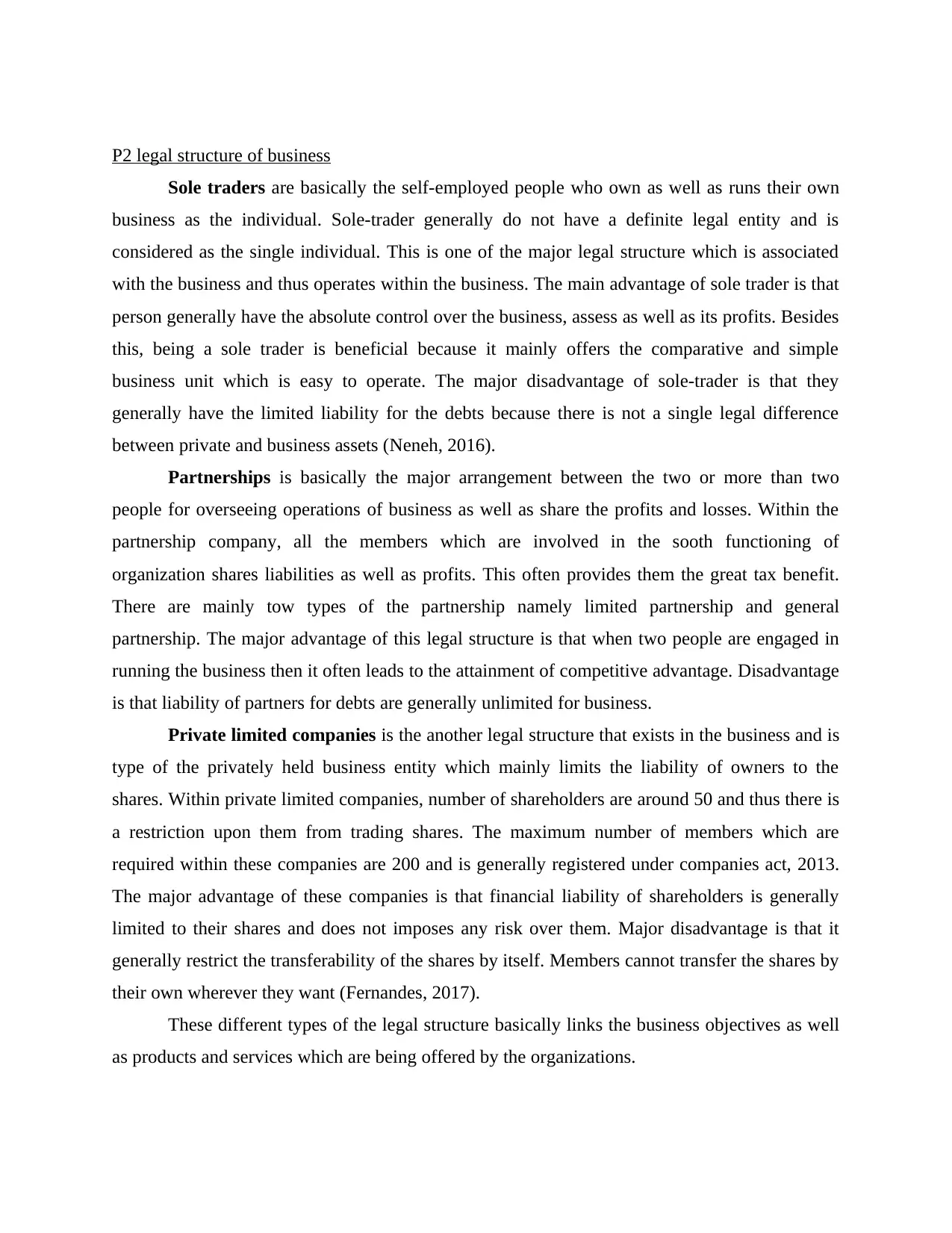
P2 legal structure of business
Sole traders are basically the self-employed people who own as well as runs their own
business as the individual. Sole-trader generally do not have a definite legal entity and is
considered as the single individual. This is one of the major legal structure which is associated
with the business and thus operates within the business. The main advantage of sole trader is that
person generally have the absolute control over the business, assess as well as its profits. Besides
this, being a sole trader is beneficial because it mainly offers the comparative and simple
business unit which is easy to operate. The major disadvantage of sole-trader is that they
generally have the limited liability for the debts because there is not a single legal difference
between private and business assets (Neneh, 2016).
Partnerships is basically the major arrangement between the two or more than two
people for overseeing operations of business as well as share the profits and losses. Within the
partnership company, all the members which are involved in the sooth functioning of
organization shares liabilities as well as profits. This often provides them the great tax benefit.
There are mainly tow types of the partnership namely limited partnership and general
partnership. The major advantage of this legal structure is that when two people are engaged in
running the business then it often leads to the attainment of competitive advantage. Disadvantage
is that liability of partners for debts are generally unlimited for business.
Private limited companies is the another legal structure that exists in the business and is
type of the privately held business entity which mainly limits the liability of owners to the
shares. Within private limited companies, number of shareholders are around 50 and thus there is
a restriction upon them from trading shares. The maximum number of members which are
required within these companies are 200 and is generally registered under companies act, 2013.
The major advantage of these companies is that financial liability of shareholders is generally
limited to their shares and does not imposes any risk over them. Major disadvantage is that it
generally restrict the transferability of the shares by itself. Members cannot transfer the shares by
their own wherever they want (Fernandes, 2017).
These different types of the legal structure basically links the business objectives as well
as products and services which are being offered by the organizations.
Sole traders are basically the self-employed people who own as well as runs their own
business as the individual. Sole-trader generally do not have a definite legal entity and is
considered as the single individual. This is one of the major legal structure which is associated
with the business and thus operates within the business. The main advantage of sole trader is that
person generally have the absolute control over the business, assess as well as its profits. Besides
this, being a sole trader is beneficial because it mainly offers the comparative and simple
business unit which is easy to operate. The major disadvantage of sole-trader is that they
generally have the limited liability for the debts because there is not a single legal difference
between private and business assets (Neneh, 2016).
Partnerships is basically the major arrangement between the two or more than two
people for overseeing operations of business as well as share the profits and losses. Within the
partnership company, all the members which are involved in the sooth functioning of
organization shares liabilities as well as profits. This often provides them the great tax benefit.
There are mainly tow types of the partnership namely limited partnership and general
partnership. The major advantage of this legal structure is that when two people are engaged in
running the business then it often leads to the attainment of competitive advantage. Disadvantage
is that liability of partners for debts are generally unlimited for business.
Private limited companies is the another legal structure that exists in the business and is
type of the privately held business entity which mainly limits the liability of owners to the
shares. Within private limited companies, number of shareholders are around 50 and thus there is
a restriction upon them from trading shares. The maximum number of members which are
required within these companies are 200 and is generally registered under companies act, 2013.
The major advantage of these companies is that financial liability of shareholders is generally
limited to their shares and does not imposes any risk over them. Major disadvantage is that it
generally restrict the transferability of the shares by itself. Members cannot transfer the shares by
their own wherever they want (Fernandes, 2017).
These different types of the legal structure basically links the business objectives as well
as products and services which are being offered by the organizations.

Sole traders
(Softwire)
Partnership
(John Lewis
partnership firm)
Private limited
(Arcadia Group)
Background This is the It firm that
offers IT solutions to
consumers. This is
operating in limited
areas only.
This is operating in
retail industry, it was
founded in 1929
This is the big firm
that operates in retail
sector.
Legal structure Company has
business owner who
takes decision on
behalf of business.
Owner has all
responsibility of
liability and profit of
firm.
This is partnership
firm where partners
of the business share
profit and loss. They
spend capital equally
and get shares in
profit according to
their investments.
Being a private firm
it is essential for
business to maintain
all records and have
to conduct audit
every year.
Market size Company has
employed 159
employees. It has
generated 14.7M
revenue in the year
2018 (Akhter, 2017).
In the year 2018 John
Lewis has generated
revenue of
10.2billion. It has
83000 employees
worldwide.
This has 2500 outlets
globally and this has
employed 22000
employees
worldwide.
Scope Firm has ability and
potential to grow
well, as it can expand
business in global
market successfully.
Its employees are
loyal and retaining in
business, this has
capability to enter
into new market.
Firm has wide scope
of expanding
business sin
international market.
This has great
financial resources
which make it more
eligible firm to enter
into new market
(Yang, 2017).
Objective Its main agenda is to
attract more corporate
clients and make
them positive by
serving them best.
Objective of John
Lewis is to generate
more profit and
sustain in market for
longer duration.
This has objective to
gain more profit.
Product and
services
IT related products
and services are
provided by
company.
It provides cloths,
watches, cosmetics
etc. products.
It offers shoes,
clothing, accessories
etc.
(Softwire)
Partnership
(John Lewis
partnership firm)
Private limited
(Arcadia Group)
Background This is the It firm that
offers IT solutions to
consumers. This is
operating in limited
areas only.
This is operating in
retail industry, it was
founded in 1929
This is the big firm
that operates in retail
sector.
Legal structure Company has
business owner who
takes decision on
behalf of business.
Owner has all
responsibility of
liability and profit of
firm.
This is partnership
firm where partners
of the business share
profit and loss. They
spend capital equally
and get shares in
profit according to
their investments.
Being a private firm
it is essential for
business to maintain
all records and have
to conduct audit
every year.
Market size Company has
employed 159
employees. It has
generated 14.7M
revenue in the year
2018 (Akhter, 2017).
In the year 2018 John
Lewis has generated
revenue of
10.2billion. It has
83000 employees
worldwide.
This has 2500 outlets
globally and this has
employed 22000
employees
worldwide.
Scope Firm has ability and
potential to grow
well, as it can expand
business in global
market successfully.
Its employees are
loyal and retaining in
business, this has
capability to enter
into new market.
Firm has wide scope
of expanding
business sin
international market.
This has great
financial resources
which make it more
eligible firm to enter
into new market
(Yang, 2017).
Objective Its main agenda is to
attract more corporate
clients and make
them positive by
serving them best.
Objective of John
Lewis is to generate
more profit and
sustain in market for
longer duration.
This has objective to
gain more profit.
Product and
services
IT related products
and services are
provided by
company.
It provides cloths,
watches, cosmetics
etc. products.
It offers shoes,
clothing, accessories
etc.
⊘ This is a preview!⊘
Do you want full access?
Subscribe today to unlock all pages.

Trusted by 1+ million students worldwide
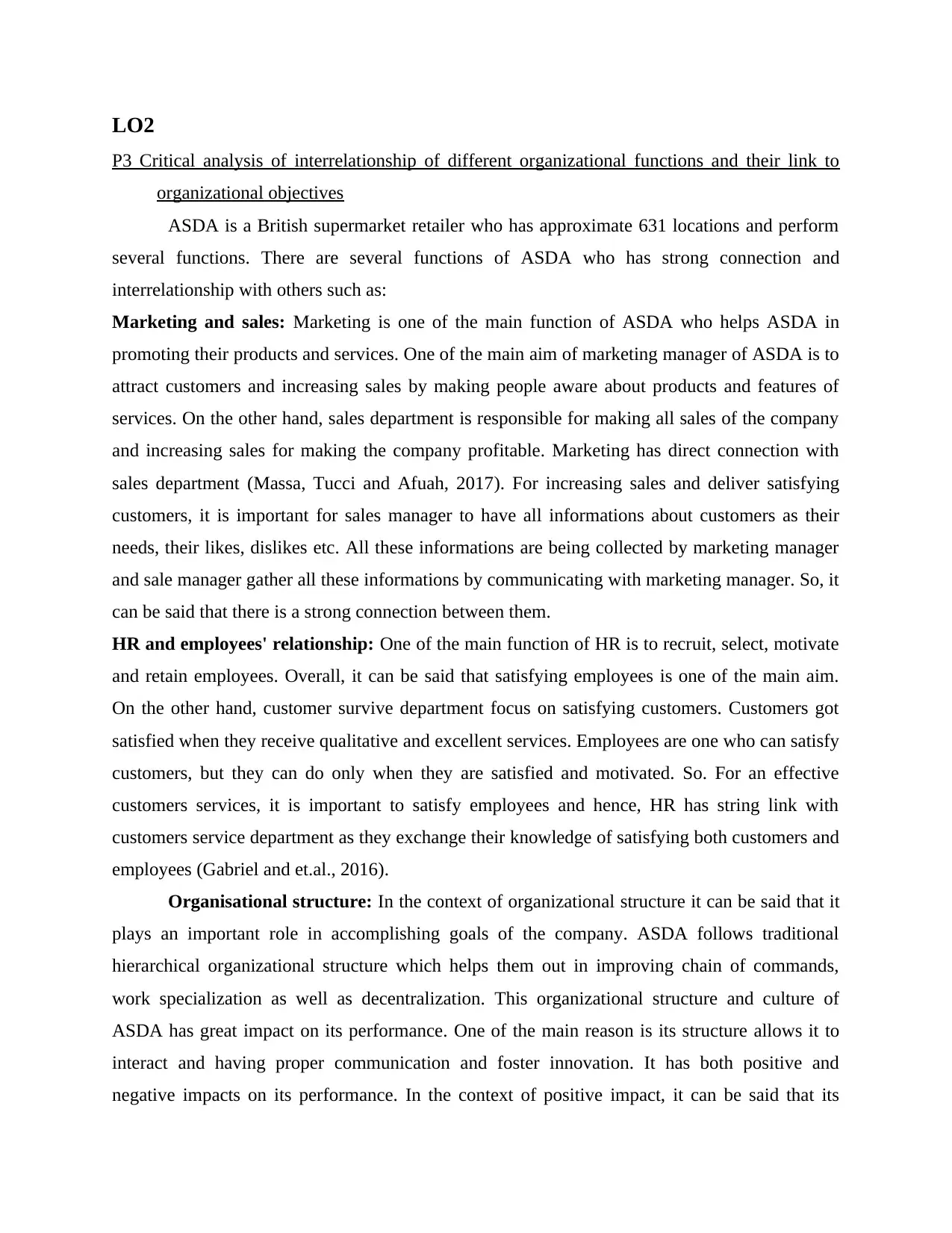
LO2
P3 Critical analysis of interrelationship of different organizational functions and their link to
organizational objectives
ASDA is a British supermarket retailer who has approximate 631 locations and perform
several functions. There are several functions of ASDA who has strong connection and
interrelationship with others such as:
Marketing and sales: Marketing is one of the main function of ASDA who helps ASDA in
promoting their products and services. One of the main aim of marketing manager of ASDA is to
attract customers and increasing sales by making people aware about products and features of
services. On the other hand, sales department is responsible for making all sales of the company
and increasing sales for making the company profitable. Marketing has direct connection with
sales department (Massa, Tucci and Afuah, 2017). For increasing sales and deliver satisfying
customers, it is important for sales manager to have all informations about customers as their
needs, their likes, dislikes etc. All these informations are being collected by marketing manager
and sale manager gather all these informations by communicating with marketing manager. So, it
can be said that there is a strong connection between them.
HR and employees' relationship: One of the main function of HR is to recruit, select, motivate
and retain employees. Overall, it can be said that satisfying employees is one of the main aim.
On the other hand, customer survive department focus on satisfying customers. Customers got
satisfied when they receive qualitative and excellent services. Employees are one who can satisfy
customers, but they can do only when they are satisfied and motivated. So. For an effective
customers services, it is important to satisfy employees and hence, HR has string link with
customers service department as they exchange their knowledge of satisfying both customers and
employees (Gabriel and et.al., 2016).
Organisational structure: In the context of organizational structure it can be said that it
plays an important role in accomplishing goals of the company. ASDA follows traditional
hierarchical organizational structure which helps them out in improving chain of commands,
work specialization as well as decentralization. This organizational structure and culture of
ASDA has great impact on its performance. One of the main reason is its structure allows it to
interact and having proper communication and foster innovation. It has both positive and
negative impacts on its performance. In the context of positive impact, it can be said that its
P3 Critical analysis of interrelationship of different organizational functions and their link to
organizational objectives
ASDA is a British supermarket retailer who has approximate 631 locations and perform
several functions. There are several functions of ASDA who has strong connection and
interrelationship with others such as:
Marketing and sales: Marketing is one of the main function of ASDA who helps ASDA in
promoting their products and services. One of the main aim of marketing manager of ASDA is to
attract customers and increasing sales by making people aware about products and features of
services. On the other hand, sales department is responsible for making all sales of the company
and increasing sales for making the company profitable. Marketing has direct connection with
sales department (Massa, Tucci and Afuah, 2017). For increasing sales and deliver satisfying
customers, it is important for sales manager to have all informations about customers as their
needs, their likes, dislikes etc. All these informations are being collected by marketing manager
and sale manager gather all these informations by communicating with marketing manager. So, it
can be said that there is a strong connection between them.
HR and employees' relationship: One of the main function of HR is to recruit, select, motivate
and retain employees. Overall, it can be said that satisfying employees is one of the main aim.
On the other hand, customer survive department focus on satisfying customers. Customers got
satisfied when they receive qualitative and excellent services. Employees are one who can satisfy
customers, but they can do only when they are satisfied and motivated. So. For an effective
customers services, it is important to satisfy employees and hence, HR has string link with
customers service department as they exchange their knowledge of satisfying both customers and
employees (Gabriel and et.al., 2016).
Organisational structure: In the context of organizational structure it can be said that it
plays an important role in accomplishing goals of the company. ASDA follows traditional
hierarchical organizational structure which helps them out in improving chain of commands,
work specialization as well as decentralization. This organizational structure and culture of
ASDA has great impact on its performance. One of the main reason is its structure allows it to
interact and having proper communication and foster innovation. It has both positive and
negative impacts on its performance. In the context of positive impact, it can be said that its
Paraphrase This Document
Need a fresh take? Get an instant paraphrase of this document with our AI Paraphraser
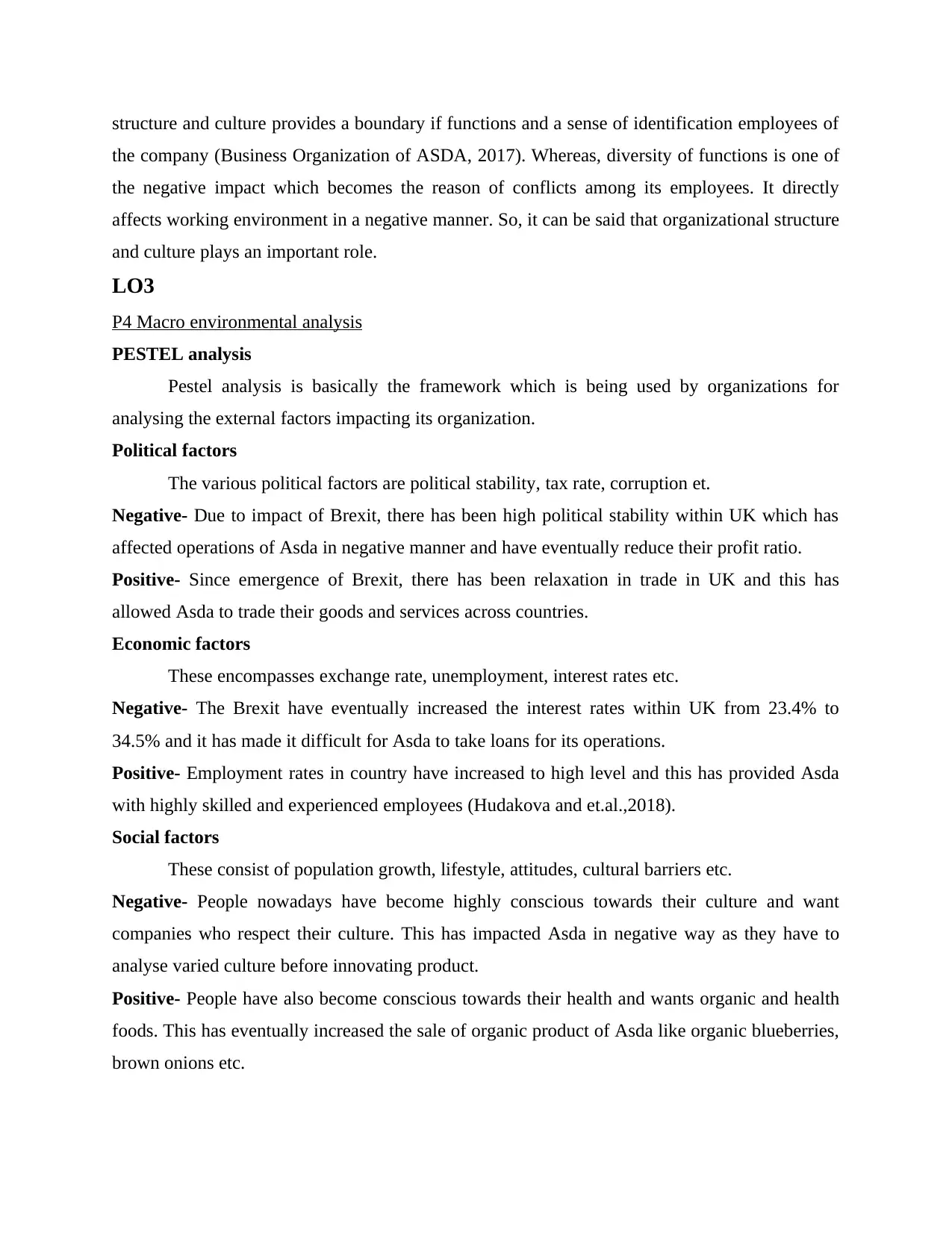
structure and culture provides a boundary if functions and a sense of identification employees of
the company (Business Organization of ASDA, 2017). Whereas, diversity of functions is one of
the negative impact which becomes the reason of conflicts among its employees. It directly
affects working environment in a negative manner. So, it can be said that organizational structure
and culture plays an important role.
LO3
P4 Macro environmental analysis
PESTEL analysis
Pestel analysis is basically the framework which is being used by organizations for
analysing the external factors impacting its organization.
Political factors
The various political factors are political stability, tax rate, corruption et.
Negative- Due to impact of Brexit, there has been high political stability within UK which has
affected operations of Asda in negative manner and have eventually reduce their profit ratio.
Positive- Since emergence of Brexit, there has been relaxation in trade in UK and this has
allowed Asda to trade their goods and services across countries.
Economic factors
These encompasses exchange rate, unemployment, interest rates etc.
Negative- The Brexit have eventually increased the interest rates within UK from 23.4% to
34.5% and it has made it difficult for Asda to take loans for its operations.
Positive- Employment rates in country have increased to high level and this has provided Asda
with highly skilled and experienced employees (Hudakova and et.al.,2018).
Social factors
These consist of population growth, lifestyle, attitudes, cultural barriers etc.
Negative- People nowadays have become highly conscious towards their culture and want
companies who respect their culture. This has impacted Asda in negative way as they have to
analyse varied culture before innovating product.
Positive- People have also become conscious towards their health and wants organic and health
foods. This has eventually increased the sale of organic product of Asda like organic blueberries,
brown onions etc.
the company (Business Organization of ASDA, 2017). Whereas, diversity of functions is one of
the negative impact which becomes the reason of conflicts among its employees. It directly
affects working environment in a negative manner. So, it can be said that organizational structure
and culture plays an important role.
LO3
P4 Macro environmental analysis
PESTEL analysis
Pestel analysis is basically the framework which is being used by organizations for
analysing the external factors impacting its organization.
Political factors
The various political factors are political stability, tax rate, corruption et.
Negative- Due to impact of Brexit, there has been high political stability within UK which has
affected operations of Asda in negative manner and have eventually reduce their profit ratio.
Positive- Since emergence of Brexit, there has been relaxation in trade in UK and this has
allowed Asda to trade their goods and services across countries.
Economic factors
These encompasses exchange rate, unemployment, interest rates etc.
Negative- The Brexit have eventually increased the interest rates within UK from 23.4% to
34.5% and it has made it difficult for Asda to take loans for its operations.
Positive- Employment rates in country have increased to high level and this has provided Asda
with highly skilled and experienced employees (Hudakova and et.al.,2018).
Social factors
These consist of population growth, lifestyle, attitudes, cultural barriers etc.
Negative- People nowadays have become highly conscious towards their culture and want
companies who respect their culture. This has impacted Asda in negative way as they have to
analyse varied culture before innovating product.
Positive- People have also become conscious towards their health and wants organic and health
foods. This has eventually increased the sale of organic product of Asda like organic blueberries,
brown onions etc.
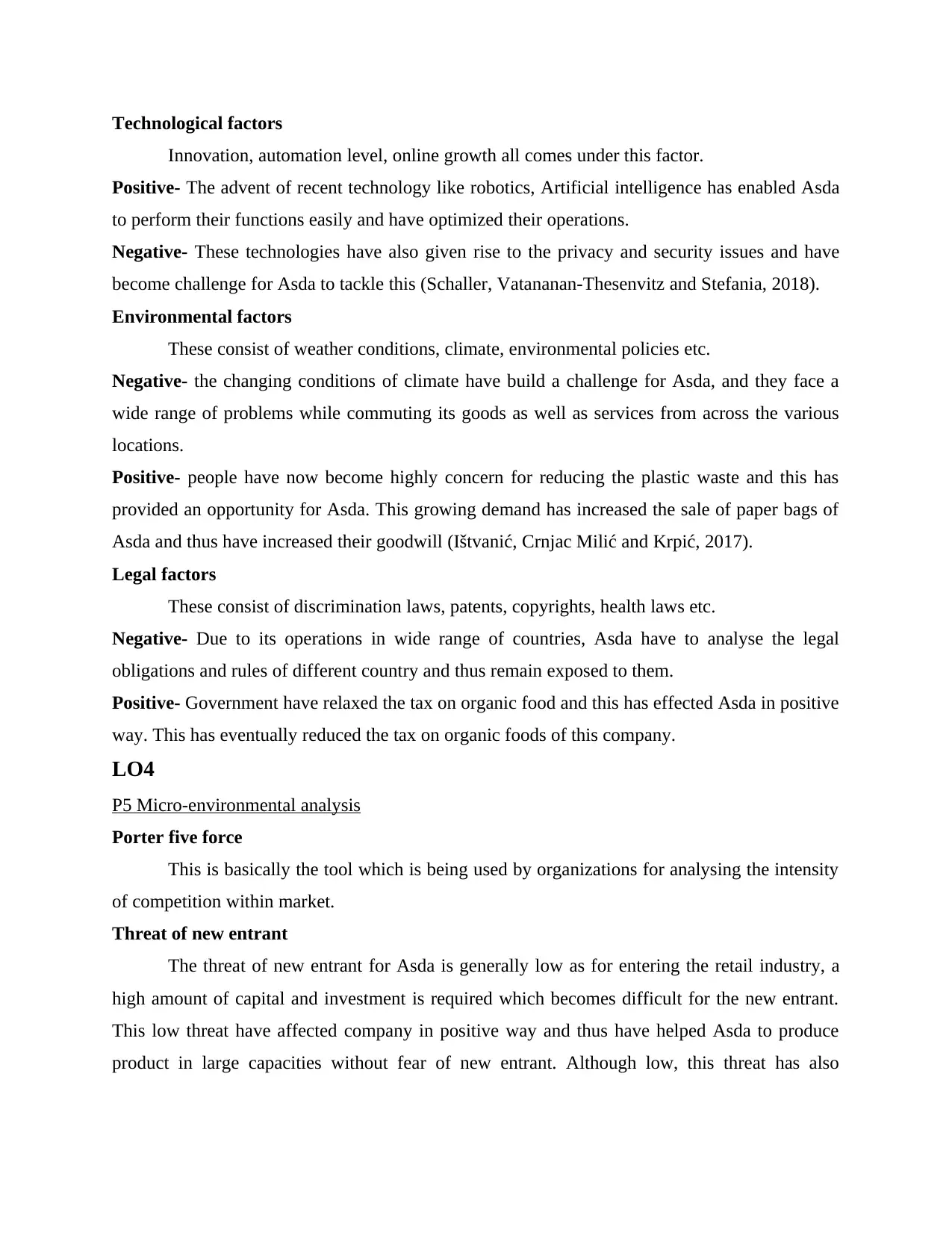
Technological factors
Innovation, automation level, online growth all comes under this factor.
Positive- The advent of recent technology like robotics, Artificial intelligence has enabled Asda
to perform their functions easily and have optimized their operations.
Negative- These technologies have also given rise to the privacy and security issues and have
become challenge for Asda to tackle this (Schaller, Vatananan-Thesenvitz and Stefania, 2018).
Environmental factors
These consist of weather conditions, climate, environmental policies etc.
Negative- the changing conditions of climate have build a challenge for Asda, and they face a
wide range of problems while commuting its goods as well as services from across the various
locations.
Positive- people have now become highly concern for reducing the plastic waste and this has
provided an opportunity for Asda. This growing demand has increased the sale of paper bags of
Asda and thus have increased their goodwill (Ištvanić, Crnjac Milić and Krpić, 2017).
Legal factors
These consist of discrimination laws, patents, copyrights, health laws etc.
Negative- Due to its operations in wide range of countries, Asda have to analyse the legal
obligations and rules of different country and thus remain exposed to them.
Positive- Government have relaxed the tax on organic food and this has effected Asda in positive
way. This has eventually reduced the tax on organic foods of this company.
LO4
P5 Micro-environmental analysis
Porter five force
This is basically the tool which is being used by organizations for analysing the intensity
of competition within market.
Threat of new entrant
The threat of new entrant for Asda is generally low as for entering the retail industry, a
high amount of capital and investment is required which becomes difficult for the new entrant.
This low threat have affected company in positive way and thus have helped Asda to produce
product in large capacities without fear of new entrant. Although low, this threat has also
Innovation, automation level, online growth all comes under this factor.
Positive- The advent of recent technology like robotics, Artificial intelligence has enabled Asda
to perform their functions easily and have optimized their operations.
Negative- These technologies have also given rise to the privacy and security issues and have
become challenge for Asda to tackle this (Schaller, Vatananan-Thesenvitz and Stefania, 2018).
Environmental factors
These consist of weather conditions, climate, environmental policies etc.
Negative- the changing conditions of climate have build a challenge for Asda, and they face a
wide range of problems while commuting its goods as well as services from across the various
locations.
Positive- people have now become highly concern for reducing the plastic waste and this has
provided an opportunity for Asda. This growing demand has increased the sale of paper bags of
Asda and thus have increased their goodwill (Ištvanić, Crnjac Milić and Krpić, 2017).
Legal factors
These consist of discrimination laws, patents, copyrights, health laws etc.
Negative- Due to its operations in wide range of countries, Asda have to analyse the legal
obligations and rules of different country and thus remain exposed to them.
Positive- Government have relaxed the tax on organic food and this has effected Asda in positive
way. This has eventually reduced the tax on organic foods of this company.
LO4
P5 Micro-environmental analysis
Porter five force
This is basically the tool which is being used by organizations for analysing the intensity
of competition within market.
Threat of new entrant
The threat of new entrant for Asda is generally low as for entering the retail industry, a
high amount of capital and investment is required which becomes difficult for the new entrant.
This low threat have affected company in positive way and thus have helped Asda to produce
product in large capacities without fear of new entrant. Although low, this threat has also
⊘ This is a preview!⊘
Do you want full access?
Subscribe today to unlock all pages.

Trusted by 1+ million students worldwide
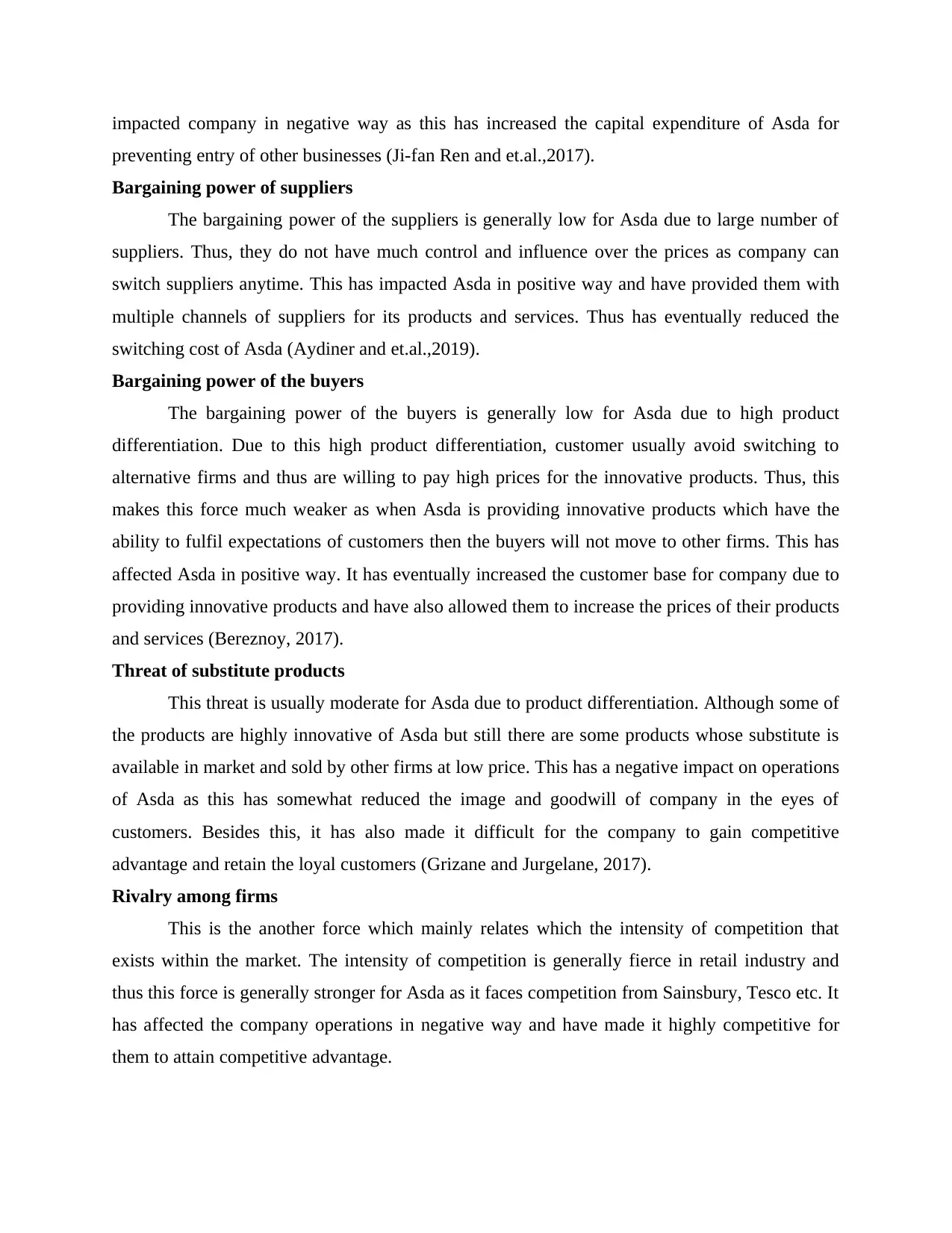
impacted company in negative way as this has increased the capital expenditure of Asda for
preventing entry of other businesses (Ji-fan Ren and et.al.,2017).
Bargaining power of suppliers
The bargaining power of the suppliers is generally low for Asda due to large number of
suppliers. Thus, they do not have much control and influence over the prices as company can
switch suppliers anytime. This has impacted Asda in positive way and have provided them with
multiple channels of suppliers for its products and services. Thus has eventually reduced the
switching cost of Asda (Aydiner and et.al.,2019).
Bargaining power of the buyers
The bargaining power of the buyers is generally low for Asda due to high product
differentiation. Due to this high product differentiation, customer usually avoid switching to
alternative firms and thus are willing to pay high prices for the innovative products. Thus, this
makes this force much weaker as when Asda is providing innovative products which have the
ability to fulfil expectations of customers then the buyers will not move to other firms. This has
affected Asda in positive way. It has eventually increased the customer base for company due to
providing innovative products and have also allowed them to increase the prices of their products
and services (Bereznoy, 2017).
Threat of substitute products
This threat is usually moderate for Asda due to product differentiation. Although some of
the products are highly innovative of Asda but still there are some products whose substitute is
available in market and sold by other firms at low price. This has a negative impact on operations
of Asda as this has somewhat reduced the image and goodwill of company in the eyes of
customers. Besides this, it has also made it difficult for the company to gain competitive
advantage and retain the loyal customers (Grizane and Jurgelane, 2017).
Rivalry among firms
This is the another force which mainly relates which the intensity of competition that
exists within the market. The intensity of competition is generally fierce in retail industry and
thus this force is generally stronger for Asda as it faces competition from Sainsbury, Tesco etc. It
has affected the company operations in negative way and have made it highly competitive for
them to attain competitive advantage.
preventing entry of other businesses (Ji-fan Ren and et.al.,2017).
Bargaining power of suppliers
The bargaining power of the suppliers is generally low for Asda due to large number of
suppliers. Thus, they do not have much control and influence over the prices as company can
switch suppliers anytime. This has impacted Asda in positive way and have provided them with
multiple channels of suppliers for its products and services. Thus has eventually reduced the
switching cost of Asda (Aydiner and et.al.,2019).
Bargaining power of the buyers
The bargaining power of the buyers is generally low for Asda due to high product
differentiation. Due to this high product differentiation, customer usually avoid switching to
alternative firms and thus are willing to pay high prices for the innovative products. Thus, this
makes this force much weaker as when Asda is providing innovative products which have the
ability to fulfil expectations of customers then the buyers will not move to other firms. This has
affected Asda in positive way. It has eventually increased the customer base for company due to
providing innovative products and have also allowed them to increase the prices of their products
and services (Bereznoy, 2017).
Threat of substitute products
This threat is usually moderate for Asda due to product differentiation. Although some of
the products are highly innovative of Asda but still there are some products whose substitute is
available in market and sold by other firms at low price. This has a negative impact on operations
of Asda as this has somewhat reduced the image and goodwill of company in the eyes of
customers. Besides this, it has also made it difficult for the company to gain competitive
advantage and retain the loyal customers (Grizane and Jurgelane, 2017).
Rivalry among firms
This is the another force which mainly relates which the intensity of competition that
exists within the market. The intensity of competition is generally fierce in retail industry and
thus this force is generally stronger for Asda as it faces competition from Sainsbury, Tesco etc. It
has affected the company operations in negative way and have made it highly competitive for
them to attain competitive advantage.
Paraphrase This Document
Need a fresh take? Get an instant paraphrase of this document with our AI Paraphraser
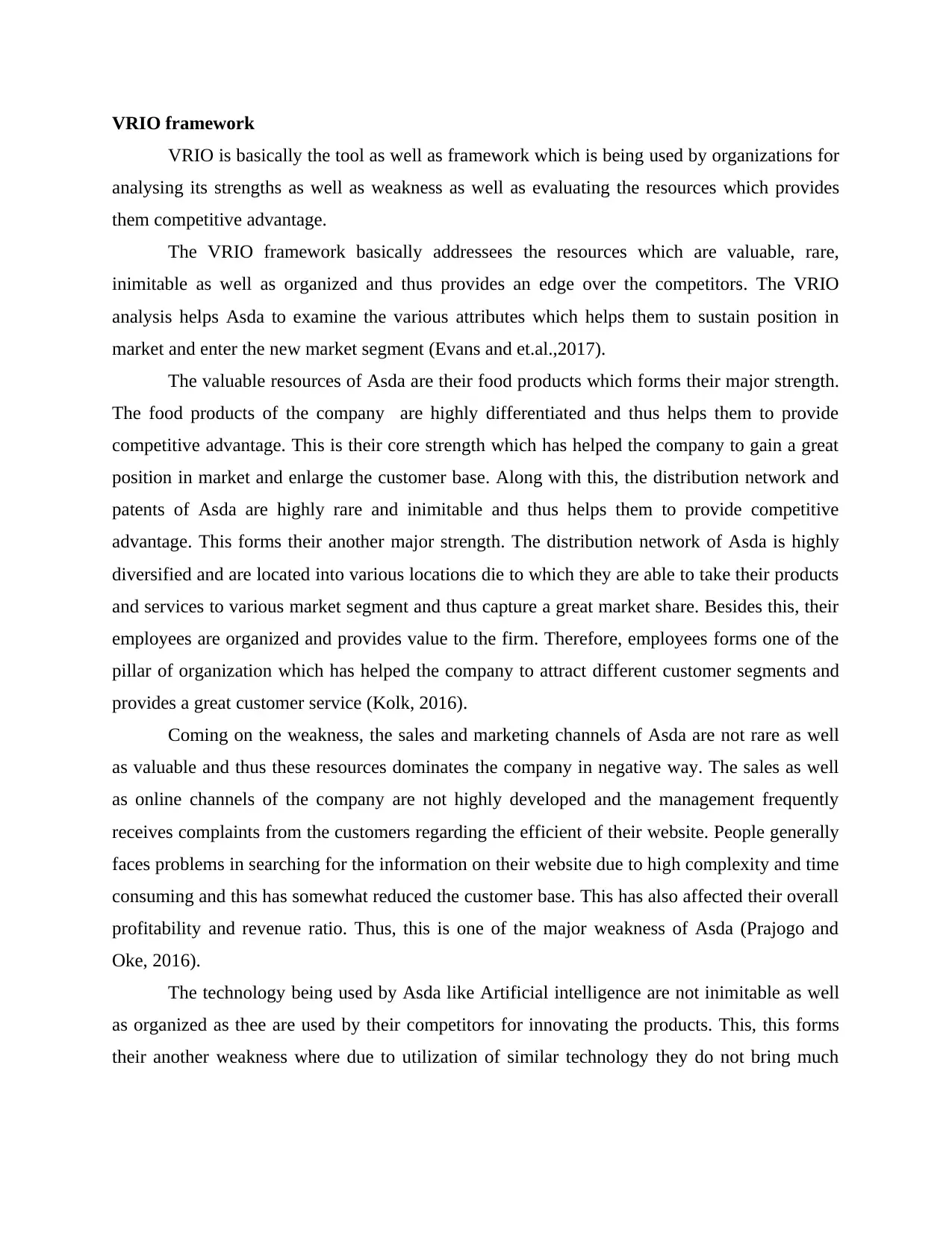
VRIO framework
VRIO is basically the tool as well as framework which is being used by organizations for
analysing its strengths as well as weakness as well as evaluating the resources which provides
them competitive advantage.
The VRIO framework basically addressees the resources which are valuable, rare,
inimitable as well as organized and thus provides an edge over the competitors. The VRIO
analysis helps Asda to examine the various attributes which helps them to sustain position in
market and enter the new market segment (Evans and et.al.,2017).
The valuable resources of Asda are their food products which forms their major strength.
The food products of the company are highly differentiated and thus helps them to provide
competitive advantage. This is their core strength which has helped the company to gain a great
position in market and enlarge the customer base. Along with this, the distribution network and
patents of Asda are highly rare and inimitable and thus helps them to provide competitive
advantage. This forms their another major strength. The distribution network of Asda is highly
diversified and are located into various locations die to which they are able to take their products
and services to various market segment and thus capture a great market share. Besides this, their
employees are organized and provides value to the firm. Therefore, employees forms one of the
pillar of organization which has helped the company to attract different customer segments and
provides a great customer service (Kolk, 2016).
Coming on the weakness, the sales and marketing channels of Asda are not rare as well
as valuable and thus these resources dominates the company in negative way. The sales as well
as online channels of the company are not highly developed and the management frequently
receives complaints from the customers regarding the efficient of their website. People generally
faces problems in searching for the information on their website due to high complexity and time
consuming and this has somewhat reduced the customer base. This has also affected their overall
profitability and revenue ratio. Thus, this is one of the major weakness of Asda (Prajogo and
Oke, 2016).
The technology being used by Asda like Artificial intelligence are not inimitable as well
as organized as thee are used by their competitors for innovating the products. This, this forms
their another weakness where due to utilization of similar technology they do not bring much
VRIO is basically the tool as well as framework which is being used by organizations for
analysing its strengths as well as weakness as well as evaluating the resources which provides
them competitive advantage.
The VRIO framework basically addressees the resources which are valuable, rare,
inimitable as well as organized and thus provides an edge over the competitors. The VRIO
analysis helps Asda to examine the various attributes which helps them to sustain position in
market and enter the new market segment (Evans and et.al.,2017).
The valuable resources of Asda are their food products which forms their major strength.
The food products of the company are highly differentiated and thus helps them to provide
competitive advantage. This is their core strength which has helped the company to gain a great
position in market and enlarge the customer base. Along with this, the distribution network and
patents of Asda are highly rare and inimitable and thus helps them to provide competitive
advantage. This forms their another major strength. The distribution network of Asda is highly
diversified and are located into various locations die to which they are able to take their products
and services to various market segment and thus capture a great market share. Besides this, their
employees are organized and provides value to the firm. Therefore, employees forms one of the
pillar of organization which has helped the company to attract different customer segments and
provides a great customer service (Kolk, 2016).
Coming on the weakness, the sales and marketing channels of Asda are not rare as well
as valuable and thus these resources dominates the company in negative way. The sales as well
as online channels of the company are not highly developed and the management frequently
receives complaints from the customers regarding the efficient of their website. People generally
faces problems in searching for the information on their website due to high complexity and time
consuming and this has somewhat reduced the customer base. This has also affected their overall
profitability and revenue ratio. Thus, this is one of the major weakness of Asda (Prajogo and
Oke, 2016).
The technology being used by Asda like Artificial intelligence are not inimitable as well
as organized as thee are used by their competitors for innovating the products. This, this forms
their another weakness where due to utilization of similar technology they do not bring much
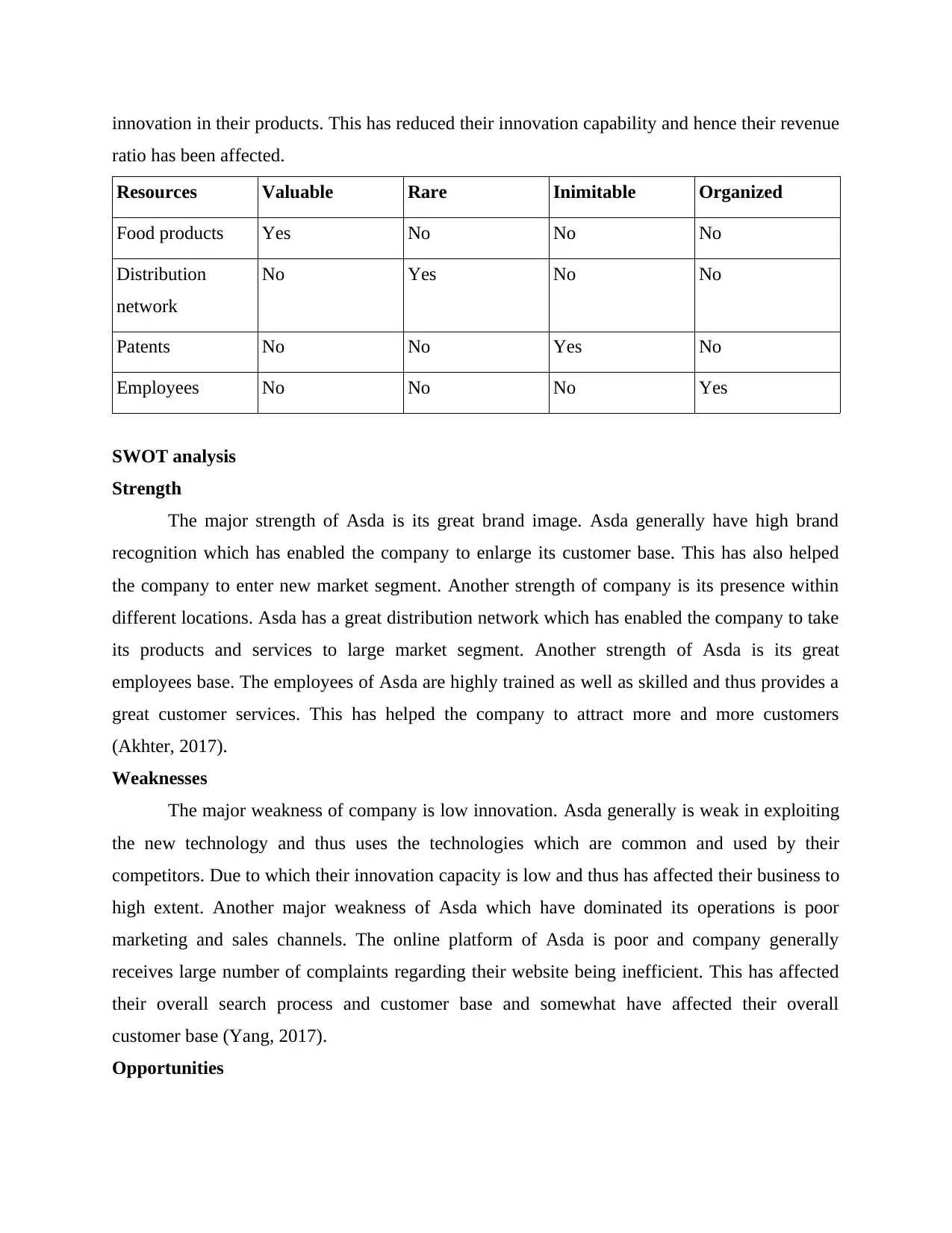
innovation in their products. This has reduced their innovation capability and hence their revenue
ratio has been affected.
Resources Valuable Rare Inimitable Organized
Food products Yes No No No
Distribution
network
No Yes No No
Patents No No Yes No
Employees No No No Yes
SWOT analysis
Strength
The major strength of Asda is its great brand image. Asda generally have high brand
recognition which has enabled the company to enlarge its customer base. This has also helped
the company to enter new market segment. Another strength of company is its presence within
different locations. Asda has a great distribution network which has enabled the company to take
its products and services to large market segment. Another strength of Asda is its great
employees base. The employees of Asda are highly trained as well as skilled and thus provides a
great customer services. This has helped the company to attract more and more customers
(Akhter, 2017).
Weaknesses
The major weakness of company is low innovation. Asda generally is weak in exploiting
the new technology and thus uses the technologies which are common and used by their
competitors. Due to which their innovation capacity is low and thus has affected their business to
high extent. Another major weakness of Asda which have dominated its operations is poor
marketing and sales channels. The online platform of Asda is poor and company generally
receives large number of complaints regarding their website being inefficient. This has affected
their overall search process and customer base and somewhat have affected their overall
customer base (Yang, 2017).
Opportunities
ratio has been affected.
Resources Valuable Rare Inimitable Organized
Food products Yes No No No
Distribution
network
No Yes No No
Patents No No Yes No
Employees No No No Yes
SWOT analysis
Strength
The major strength of Asda is its great brand image. Asda generally have high brand
recognition which has enabled the company to enlarge its customer base. This has also helped
the company to enter new market segment. Another strength of company is its presence within
different locations. Asda has a great distribution network which has enabled the company to take
its products and services to large market segment. Another strength of Asda is its great
employees base. The employees of Asda are highly trained as well as skilled and thus provides a
great customer services. This has helped the company to attract more and more customers
(Akhter, 2017).
Weaknesses
The major weakness of company is low innovation. Asda generally is weak in exploiting
the new technology and thus uses the technologies which are common and used by their
competitors. Due to which their innovation capacity is low and thus has affected their business to
high extent. Another major weakness of Asda which have dominated its operations is poor
marketing and sales channels. The online platform of Asda is poor and company generally
receives large number of complaints regarding their website being inefficient. This has affected
their overall search process and customer base and somewhat have affected their overall
customer base (Yang, 2017).
Opportunities
⊘ This is a preview!⊘
Do you want full access?
Subscribe today to unlock all pages.

Trusted by 1+ million students worldwide
1 out of 17
Related Documents
Your All-in-One AI-Powered Toolkit for Academic Success.
+13062052269
info@desklib.com
Available 24*7 on WhatsApp / Email
![[object Object]](/_next/static/media/star-bottom.7253800d.svg)
Unlock your academic potential
Copyright © 2020–2025 A2Z Services. All Rights Reserved. Developed and managed by ZUCOL.




